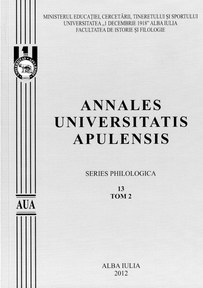Les références culturelles dans Les songes et les sorts de Marguerite Yourcenar
Cultural References in Les songes et les sorts by Marguerite Yourcenar
Author(s): Cristiana Bulgaru-TeşculăSubject(s): Literary Texts
Published by: Universitatea »1 Decembrie 1918« Alba Iulia
Keywords: dream’s scenery; geographical and visual arts references
Summary/Abstract: “Les Songes et les Sorts”, the collection of oniric transcriptions of Marguerite Yourcenar is a real demonstration of erudition serving the accurate reconstruction of the performance primarily of a visual nature which is represented by the dream. It starts with the essay-preface doubled by an elliptic and subjective history of the dream with scientific, prescientific and literary references. The preface reunites several remarks on the defining characteristics of the dream (structure, resources, transformation procedea, affective load, visual dimension).The author pays special attention to the visual dimension of the dream which can be set into words, communicated to the others and understood by them, due to a common framework of reference of an aesthetic value which is unanimously acknowledged. It consists in geographical and visual arts references. Thus, in order that the reader might be capable of representing a certain town space squinted in her dreams by the authoress. In the transcriptions entitled “Les Clefs de l’église” and “L’Île des dragons” reference is made to very well known places on the basis of significant details for their day time geography (canals crossing aquatic towns like Bruges, Harlem or Venice), or to pieces of architecture that cannot be mistaken (Venetian palaces, the Kremlin). The dream’s scenery - a cathedral or a church - give away the authoress’ preference for the gothic and baroque architecture. That is why these spaces gain the circular configuration of the famous church of San Pietro, but not its sumptuous interior ornamentations: (“La Flaque dans l’église”); or they associate elements of the external gothic architecture from several sources (the cathedral of Chartres, Canterbury or Lausanne), giving up the exterior ornamentation pertaining to that style (“Les Visions dans la cathédrale”). It might be said that in the world of the dreams, the churches and the cathedrals no longer have the mission of intermediating the meeting with the divinity, but they offer lectures in art history. They constitute a kind of open museum under certain circumstances (darkness, cold, dim light, capricious visiting hours) and have, in general, a unique visitor, she who dreams, and a unique exhibit, remarkable indeed – a statue or a canvas which invariably represent a feminine divinity: the statue of the Virgin who blesses the people, a kind of replica of the antique Athens Partenos seated in the lap of another gigantic Virgin (“Les Cierges dans la cathédrale”), a Madonna feeding her child Madonna feeding her child in the tradition of the primitive Flemish painting: (“Les Visions dans la cathédrale”). These geographical or artistic references are meant to establish a common language between the dreamer and the reader and attribute an intelligible character to the dream in spite of the obvious bizarreness, even when taking over very well known yard sticks.
Journal: Annales Universitatis Apulensis. Series Philologica
- Issue Year: 13/2012
- Issue No: 2
- Page Range: 217-228
- Page Count: 12
- Language: French

